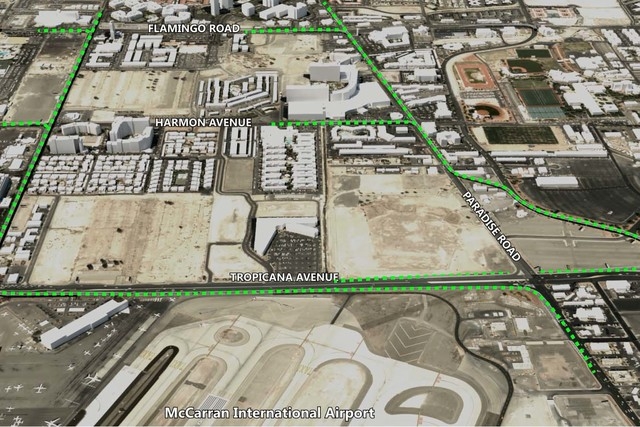Elevated McCarran airport expressway plan moves forward

Clark County is moving ahead with plans to develop an elevated limited-access airport expressway along Paradise Road, Koval Lane and Tropicana Avenue despite critics’ claims that it’s a 20th-century solution to 21st-century traffic issues.
County purchasing and contracts officials on Thursday conducted a meeting with prospective bidders to explain the county’s request for qualification procedures. The deadline for bids is May 9.
County Public Works Director Denis Cederburg in January presented a plan for a pair of elevated two-lane roadways, free of traffic signals, that would move traffic north from McCarran International Airport along Paradise and south to the airport on Koval and Tropicana.
The county plan was part of a broader transportation presentation to the Southern Nevada Tourism Infrastructure Committee. The presentation, drafted by the Regional Transportation Commission of Southern Nevada, is a 2,400-page document with 65 recommended road, highway, transit and pedestrian projects geared toward the needs of the tourism economy.
But since the expressway project was unveiled, a new idea for its corridor has surfaced. Las Vegas Sands Corp. and Majestic Realty have proposed building a $1.3 billion, 65,000-seat domed stadium on land owned by UNLV at Tropicana and Koval.
In addition, transportation and planning leaders have expressed concern that the county is moving too quickly on the expressway proposal and that resources instead should be dedicated to a different solution, potentially light rail.
Earlier this week, Tom Skancke, a public representative on the state Transportation Board, said light rail would be a better use of transportation funds, calling the elevated expressway proposal “20th-century thinking.”
County Commissioner Larry Brown, who chairs the RTC board of directors, responded at the organization’s monthly meeting Thursday that the county’s expressway plan provides a more immediate solution to a problem light rail wouldn’t be able to solve for at least 20 years.
“We’re addressing a critical need that we have today,” Brown said of the plan that would cost an estimated $200 million.
The roadways would be on bridge structures elevated over the existing street rights of way.
One portion of the Koval route couldn’t be elevated — the section along Tropicana Avenue abutting airport land near the ends of two McCarran runways. Near the runways, the road would be lowered to grade level, but kept separate from Tropicana traffic.
Based on a test Cederburg’s staff conducted during CES, he said an airport commute during evening rush hour from Harmon Avenue to the airport took more than 28 minutes. With the elevated expressways, the staff estimated the commute would take just over nine minutes.
“We can’t wait 10 to 20 years to address this, plus the project is fully funded,” Brown said. “I don’t know that I’ve ever heard of anyone criticizing a government public works project for moving too quickly.”
He said he asked a proponent of light rail how such a project would be funded.
“The response was dead silence,” he said. “There was no answer to that, and, frankly, I found that a little offensive. County public works is taking action to solve a problem in the now. Light rail is a system that is going to take decades, and that’s only after funding has been identified.”
Robert Lang, UNLV director of Brookings Mountain West, another critic of the plan, said the two-decade projection for completion of light rail is for the entire system, not the critical section between McCarran, the Strip and downtown Las Vegas.
He said a Las Vegas light-rail system would generate higher-than-national-average farebox revenue and the county’s $200 million would be better spent on that than the elevated expressway, which he derided as “a tribute to Robert Moses.”
Moses was a mid-20th-century urban planner who favored highways over public transit.
“This is going to embarrass,” Lang said of the expressway proposal. “When the RTC went to Denver to tour its light-rail system, we told them about the elevated expressway plan and they laughed at us.”
Lang also said 14 elevated expressways nationwide have either been torn down, are in the process of being torn down or being debated for demolition. Among the prominent projects: San Francisco’s Embarcadero Freeway, the Westside Elevated Highway in Manhattan and Harbor Drive in Portland, Oregon.
The Review-Journal is owned by the family of Las Vegas Sands Chairman and CEO Sheldon Adelson.
Contact Richard N. Velotta at rvelotta@reviewjournal.com or 702-477-3893. Find @RickVelotta on Twitter.